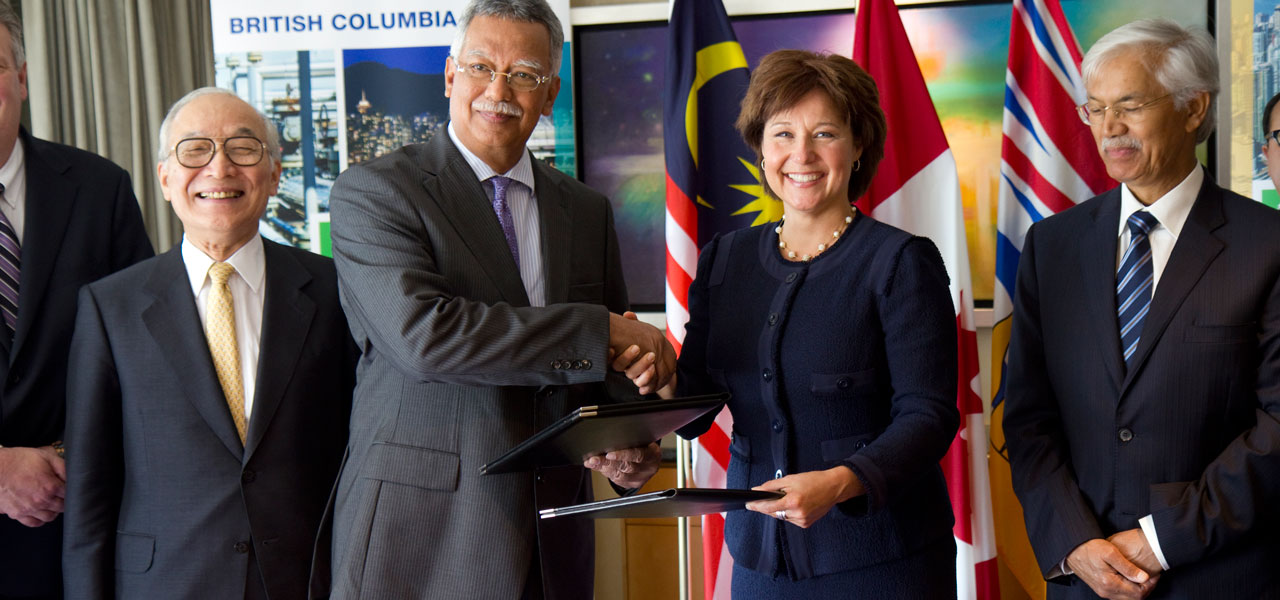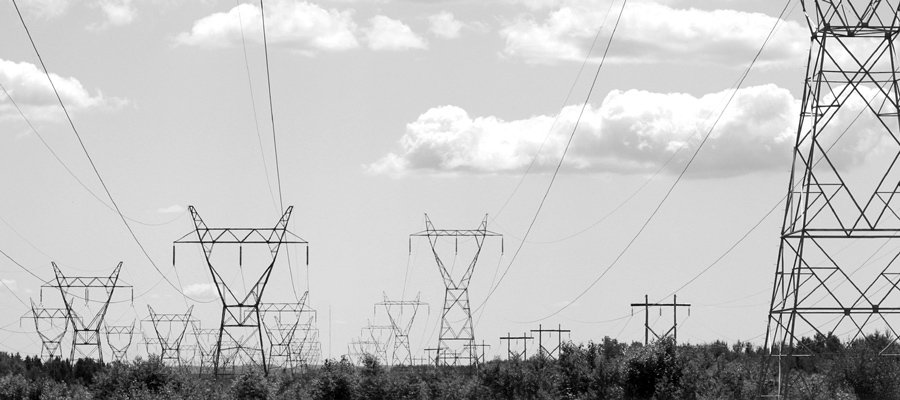This post originally appeared on DeSmog Canada.
On January 20, BC Hydro issued a press release singing the praises of a new hydro transmission line not far from where preliminary work has begun to build the $9-billion Site C dam.
The release, headlined “New transmission line to power development in the south Peace”, featuring boosterish quotes from Premier Christy Clark, Energy and Mines Minister Bill Bennett and BC Hydro CEO and president Jessica MacDonald, made no mention of the dam.
Yet it highlighted for many one of the most vexing questions about why the dam, which is the single-most expensive megaproject in the province’s history is being built: Why this project at this time?
“This line doubles the amount of power we can provide to the region,” enthused MacDonald. “We know it’s a growing region and BC Hydro needs to be one step ahead and ensure we can get power to where it is needed most. We want industry in B.C. to use clean power that comes from BC Hydro’s hydroelectric facilities.”
Exempting major transmission lines from public review
What MacDonald didn’t say, and on which Clark and Bennett certainly didn’t elaborate either, is that the $300-million and counting transmission line is but the first of at least three in the region. Another two lines, which the provincial government wants exempt from review by the provincial electrical utilities regulator the BC Utilities Commission (the province also exempted the Site C dam project from similar review), will add hundreds of millions more to the tally for taxpayers.
Also not explained anywhere by MacDonald, Clark, Bennett and company is that virtually all of this new transmission infrastructure is being built at public expense to provide power to one entity and one entity alone – the natural gas industry. An industry, that has used and continues to use small portions of the gas that it drills to fire turbines that provide the power to move the gas through pipelines to processing plants and then on to consumers.
Now, in the name of making “dirty” natural gas companies marginally less so, BC Hydro at the behest of the provincial government is aggressively pursuing a policy of providing “clean” hydroelectricity to the gas industry so that its greenhouse gas emissions are lowered here in B.C. It is this policy that provides the only credible explanation for why the Crown corporation is rushing to build the controversial dam at this time.
Indeed, BC Hydro’s own records show that in the absence of a vastly expanded natural gas sector in the province there is simply no need for the dam now or in the foreseeable future. It has told the BCUC that it will be 2028 before domestic electricity consumption actually exceeds domestic production. And even then, according to BC Hydro, there is good reason to believe that that critical point may be even further down the road.

Signs protesting the Site C dam are plentiful along Highway 29 between Fort St. John and Hudson’s Hope. Photo credit: Emma Gilchrist, DeSmog Canada (on Flickr).
Hydro rate increases pose risks to pulp & paper sector
After filing its most recent load forecasts with the BCUC, BC Hydro produced a quarterly report noting that its earlier forecasts for large industrial and commercial users were overstated. New information suggested that those consumers will likely use even less electricity in future years and that such declines could be most pronounced in key industries like the pulp and paper industry that directly and indirectly employ thousands of people.
Ironically, one of the main reasons why B.C.’s pulp and paper industry is in trouble is the rising cost of electricity. In 2014, hydro rates increased by 9 percent, the first in a planned five years of increases totalling at least 28 per cent. The increases mark just the beginning of what could be years of steadily higher bills as customers repay the billions of dollars that BC Hydro must borrow to pay for Site C and the new transmission lines.
For certain pulp mills that rely more on power than chemicals to break down wood fibre, just the most recent increases in hydro rates threaten to put some of them out of business. Provincial Finance Minister Mike de Jong was told as much in June in a letter signed by the CEOs of four major forest companies including Canfor, West Fraser, Catalyst and Paper Excellence.
“While our industry prides itself on cost-cutting through constant innovation and improvements in efficiency, the magnitude and timing of the increase in B.C. Hydro rates combined with the increase in [provincial sales] tax, may result in many of the mills shutting down,” the letter reads in part.
No wonder, then, that BC Hydro believes that there could be possible declines in hydro usage among some industrial users. If just one mechanical pulp mill in the province shuts down, enough power to supply 70,000 homes is freed up.
The only scenario in which BC Hydro envisions hydro usage in the province exceeding available supply is in the event that one or more Liquefied Natural Gas or LNG plant are built on our coast. Such plants require enormous amounts of power to super-cool natural gas to the point where it turns to liquid form and can be loaded onto tankers for shipment overseas.
Site C and LNG
According to BC Hydro filings with the BCUC it is only with the arrival of an LNG industry in the province that hydro consumption begins to outstrip domestic supply, and only then in about eight years.
Despite the fact that fossil fuel giants such as Shell and Petronas have yet to commit a dime to building LNG plants, the rush is on to supply them with hydroelectric power to offset some of the emissions associated with producing and potentially one day liquefying natural gas: a gas that no matter how you slice it is a climate-unfriendly fossil fuel that contributes significantly to global greenhouse gas emissions.
Whether or not an LNG industry emerges, however, the provincial government and BC Hydro are forging ahead with plans to supply hydroelectricity to companies drilling for natural gas in the Montney Basin. The basin, which extends out a considerable distance from the Peace River, contains B.C.’s largest remaining reserves of natural gas.
The basin has considerable “wet” natural gas deposits, which in the current environment of generally depressed natural gas prices is a good thing for the companies involved. Dry gas is generally made up of methane whereas wet gas may contain ethane, butane and pentane, or natural gasoline; all valuable hydrocarbons.
By extending transmission lines into the Montney Basin, the province and BC Hydro intend to make it more financially attractive for gas companies. None of the gas that they drill for and produce will have to be used to fire turbines that move the gas through pipelines. Instead, all of the gas saved through electrification can be sold instead, especially the wet gas with its higher market value. Both the province and BC Hydro believe that will translate into even more gas industry activity.
“Before, industrial customers had to burn gas to power their facilities. The new transmission line not only makes more projects possible, it means they’ll be even cleaner,” Premier Clark said in BC Hydro’s January 20 press release.
Electrified natural gas industry: no net climatic benefit
Of course, what neither Clark, Bennett or MacDonald say in the release is that there is actually no net benefit to the earth’s overheating atmosphere in making the gas industry here at home somewhat cleaner. While the gas industry’s greenhouse gas emissions in B.C. may be less worse than they otherwise would be, all of the gas saved through electrifying gas company field operations is simply sent down pipelines to the financial benefit of the sellers and burned somewhere else at a collective loss to the planet.
For people who have been hunkering down at a protest camp near the Site C dam construction zone where temperatures have sometimes dipped down to a bone-chilling -25 C, every new announcement extolling the virtues of a new hydroelectric transmission line reinforces the notion that BC Hydro and the provincial government have a build-it-and-they-will-come attitude with what is the single-most expensive megaproject in the province’s history.
The more transmission lines erected to allegedly “green up” the field operations of fossil fuel companies, the more fossil fuel industry activity. The more such activity, the more the government and BC Hydro can justify Site C.
The transmission line that Clark and company enthusiastically praised in the BC Hydro press release of January 20 is known as the Dawson Creek-Chetwynd Area line or DCAT. The project consisted of building two new lines of 12 kilometres and 60 kilometres in length, construction of a new substation, and upgrades to two other facilities.
BC Hydro’s press release states that DCAT’s cost is $296 million. But a document that the Crown corporation filed last fall with the BCUC tells a different story. In that document, the actual cost of the project as of September was just under $302 million or nearly $6 million higher than that stated in BC Hydro’s press release. And the document, which is signed by BC Hydro’s chief regulatory officer, Tom Loski, notes that the project is not yet completed. So there will be further costs, including those associated with taking down all of the lower kilovolt lines that the new transmission infrastructure replaced.
BC Hydro is required by law to file information on the DCAT project because that project was subject to BCUC review. The public therefore has access to details on the project. But the provincial government has indicated that two other new massive hydroelectric transmission line projects, both in the Peace region and both being built primarily to service natural gas company field operations, will not be subject to such reviews and therefore the public may learn little to nothing about.
Last November, Energy Minister Bennett explained why the government did not want the projects brought before the BCUC. In a Business Vancouver story, Bennett said:
“My understanding right now is that if I do not direct the BCUC to allow these projects to go ahead, that we may lose some interest on the part of the gas companies . . . They just don’t feel that they can wait for a long BCUC process.”
But local politicians such as Karen Goodings, Area B director for the Peace River Regional District, are decidedly uneasy with excluding the two major transmission line projects from review.
“Our concern, of course, is once again the avoidance of going through the process that is in place to examine these things,” Goodings told Business Vancouver. “It’s almost as though this is another excuse for building Site C.”
An unusual wrinkle of one of the proposed transmission lines known as the North Montney Power Supply Project, is that the 140 kilometre-long line will be built by a private company. Atco Power will build the transmission infrastructure to deliver electricity to the remote Pink Mountain area well to the north of Fort St. John. The area is the site of major gas-drilling and fracking operations by Progress Energy, owned by the Malaysian state-owned corporation, Petronas.
“Aggressive schedule” to carry hydroelectricity to gas industry
In a letter last March to Les MacLaren, an assistant deputy minister in Bennett’s ministry, ATCO vice-president Dale Friesen explained why neither ATCO nor Petronas want the project subject to BCUC review.
Friesen said a “ministerial exemption” exempting the project from BCUC review was being sought because of the “aggressive schedule” required to build the project.
“Progress Energy is developing gas production capacity in the North Montney Basin in support of the Pacific Northwest LNG project proposed by Petronas, Progress’ parent company.”
“ . . . By utilizing BC Hydro supplied power instead of burning natural gas, Progress expects to decrease emissions in the region by approximately a third. Progress further expects to realize improved equipment performance, decreasing the risk associated with gas delivery to LNG facilities.”
“The project is being developed on an aggressive schedule to meet with Progress timelines. Failure to meet these timelines reduces the feasibility of electrification and poses a substantial threat to the project proceeding.”
Nothing in the information obtained by the Regional District indicates what the projected costs to build the line and related infrastructure are. But given that the line is twice the length of the DCAT line and goes through rugged and remote terrain, it seems reasonable to conclude that it will be a vastly more ambitious and expensive project.
And somehow despite all the cost associated with building the line and all of the added cost of purchasing the electricity carried by the line, Petronas is going to be financially ahead of where it would be if it burned its own gas.
Does Goodings believe that Petronas may benefit somehow by subsidies that make it financially attractive to use hydropower instead of its own gas to power its field operations? Goodings says she doesn’t know and nothing by way of information supplied to the regional district by ATCO sheds light on that question.
What she does know is that in an environment in which the provincial government is bending over backwards to entice Petronas to build an LNG plant in B.C. it makes no sense that the company would pay anything more at the end of the day for hydroelectric power than it pays for power that it produces itself.
Given that three separate transmission lines are either built or about to be built to supply electricity to an industry that has for decades produced its own power from the gas it draws from the ground, Goodings thinks the need for an independent review of all new transmission line projects in the Peace region and the Site C dam is obvious. Especially when the government’s much-touted promises of an LNG industry in the province appear more elusive.
“Are these transmission lines the reason for Site C? If that’s the reason we’re spending $9 billion then yes, there’s an impact on the taxpayer, and they should not be exempt from review,” Goodings says.
No amount of boasting about all the clean energy supplied by Site C or by the transmission lines gets around the fact that an awful lot of public money is about to be dropped in the Peace Region. Goodings, like many others who have called for the BCUC to review the Site C project, believes it’s in all of our interests to know if it is money well spent.
Topics: Climate change & energy policy, Features, Transparency & accountability






